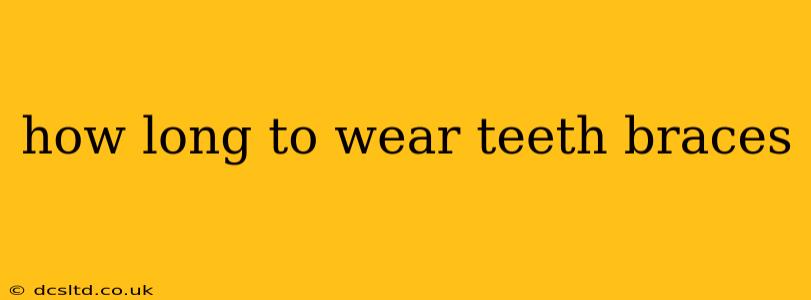The question, "How long do you have to wear braces?" is a common one, and the answer isn't a simple number. The duration of orthodontic treatment with braces varies significantly depending on several factors. This comprehensive guide will delve into these factors, providing you with a clearer understanding of what to expect.
What Factors Determine Braces Treatment Time?
Several key factors influence the length of time you'll need to wear braces:
-
Severity of Misalignment: This is perhaps the most significant factor. Minor crowding or spacing issues may only require a year or less of treatment. However, severe malocclusions (bad bites), significant overbites, underbites, or crossbites may necessitate two to three years, or even longer.
-
Type of Braces: Traditional metal braces are often faster than clear aligners like Invisalign. However, the speed also depends on individual patient compliance and the complexity of the case.
-
Age: Younger patients, whose jaws are still developing, often respond more quickly to orthodontic treatment. Adult treatment can sometimes take a little longer, due to the fact that jaw growth has stopped.
-
Patient Cooperation: Wearing your elastics (rubber bands), attending appointments regularly, and maintaining good oral hygiene are crucial for treatment success and efficient progress. Non-compliance can significantly prolong the treatment timeline.
-
Underlying Medical Conditions: Certain medical conditions can affect the rate of tooth movement and bone remodeling, potentially lengthening the treatment time.
How Long is "Average"?
While there's no magic number, the average treatment time for braces is between 18 and 24 months. However, this is just an average. Many individuals complete their treatment within 12-18 months, while others require 24-36 months, or even longer in complex cases.
What Happens After Braces Come Off?
Once your braces are removed, the treatment isn't over. You'll need to wear a retainer to maintain your newly straightened teeth. This crucial step prevents your teeth from shifting back to their original positions. The retainer wearing period can last for several years, even indefinitely for some individuals. Your orthodontist will discuss the specific retainer schedule with you.
What if My Treatment Takes Longer Than Expected?
It’s essential to understand that orthodontic treatment is a process that requires patience and consistent effort. If your treatment is taking longer than anticipated, your orthodontist will likely explain the reasons and adjust the treatment plan as needed. Open communication with your orthodontist is key to understanding the progress and timeline of your treatment.
How Can I Speed Up My Braces Treatment?
While you can't magically speed up the process, consistent cooperation greatly influences the timeline:
-
Attend all appointments: Regular check-ups are essential for monitoring progress and making necessary adjustments.
-
Wear elastics diligently: If prescribed, consistently wearing elastics as instructed is vital for successful tooth movement.
-
Maintain excellent oral hygiene: Brushing and flossing regularly prevent infections and complications that might delay treatment.
-
Follow your orthodontist's instructions precisely: Adhering to all instructions and recommendations from your orthodontist is crucial.
Can I Get Braces Faster with Clear Aligners?
While clear aligners, such as Invisalign, offer a more discreet approach, they don't necessarily guarantee faster treatment. The treatment timeline still depends on the complexity of the case and the patient's cooperation.
What are the Different Types of Braces and How Do They Affect Treatment Time?
Different types of braces exist, each with its own advantages and potential impact on treatment time:
-
Traditional Metal Braces: Generally offer the fastest treatment times due to their effectiveness in correcting complex malocclusions.
-
Ceramic Braces: Similar to metal braces in effectiveness but slightly less efficient in some cases, and more prone to breakage.
-
Lingual Braces: These are placed on the back of the teeth, offering a less visible option, but often requiring longer treatment times and potentially more challenging for the patient.
By understanding these factors, you can better manage your expectations and work effectively with your orthodontist to achieve a beautiful, healthy, and straight smile. Remember that patience and cooperation are key to a successful outcome.
